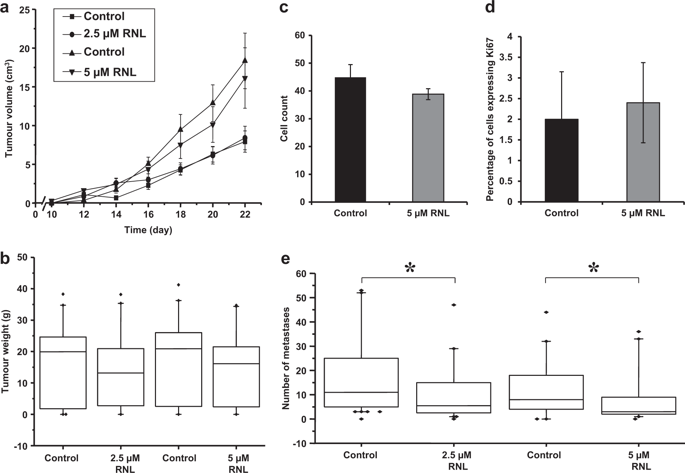当前位置:
X-MOL 学术
›
Prostate Cancer Prostatic. Dis.
›
论文详情
Our official English website, www.x-mol.net, welcomes your feedback! (Note: you will need to create a separate account there.)
Anti-metastatic effect of ranolazine in an in vivo rat model of prostate cancer, and expression of voltage-gated sodium channel protein in human prostate.
Prostate Cancer and Prostatic Diseases ( IF 4.8 ) Pub Date : 2019-03-20 , DOI: 10.1038/s41391-019-0128-3 Ilknur Bugan 1 , Selma Kucuk 1 , Zeynep Karagoz 1 , Scott P Fraser 2 , Handan Kaya 3 , Andrew Dodson 4 , Christopher S Foster 5 , Seyhan Altun 1 , Mustafa B A Djamgoz 2, 6
Prostate Cancer and Prostatic Diseases ( IF 4.8 ) Pub Date : 2019-03-20 , DOI: 10.1038/s41391-019-0128-3 Ilknur Bugan 1 , Selma Kucuk 1 , Zeynep Karagoz 1 , Scott P Fraser 2 , Handan Kaya 3 , Andrew Dodson 4 , Christopher S Foster 5 , Seyhan Altun 1 , Mustafa B A Djamgoz 2, 6
Affiliation

|
BACKGROUND
Voltage-gated Na+ channels (VGSCs) are functionally upregulated in rat and human prostate cancer (PCa) where channel activity promotes cellular invasiveness in vitro and metastasis in vivo. Ranolazine is a clinically used VGSC inhibitor/anti-anginal drug, which has been shown previously to inhibit breast cancer metastasis in vivo.
METHODS
Using the Dunning model of rat PCa, the effect of ranolazine applied systemically (by gavage) was tested on the development of primary tumours and metastases following subcutaneous inoculation of Mat-LyLu cells into Copenhagen rats. In addition, human prostate tissue microarrays were used to determine VGSC protein expression in cancerous versus non-cancerous tissue. Several public databases were searched to compare Nav1.7/ SCN9A expression levels in 'normal' vs. PCa tissues.
RESULTS
Ranolazine (2.5 and 5 µM) decreased the number of lung metastases by up to 63%. In contrast, primary tumourigenesis was not affected. Ranolazine also reduced the percentage of cells in the metastases expressing Nav1.7, the main VGSC subtype expressed in PCa, but the expression level was higher. In prostate tissue microarrays, VGSC protein expression was significantly higher in cancerous versus non-cancerous tissue. There was no correlation between the VGSC expression and either prostate-specific antigen or Gleason score. In public databases, little information could be found on Nav1.7 protein expression in PCa. In addition, the database information on Nav1.7 mRNA (SCN9A) expression levels did not correlate with previously reported upregulation in PCa cells and tissues.
CONCLUSIONS
The main conclusions were (i) ranolazine inhibited metastasis and (ii) it was a subpopulation of cells with particularly high levels of Nav1.7 protein that reached the metastatic sites. These data extend earlier studies and suggest that Nav1.7 expression could serve as a functional biomarker of metastatic PCa and that VGSC blockers may be useful as anti-metastatic agents.
中文翻译:

雷诺嗪在前列腺癌大鼠体内模型中的抗转移作用,以及电压门控钠通道蛋白在人前列腺中的表达。
背景电压门控Na+通道(VGSC)在大鼠和人前列腺癌(PCa)中功能上调,其中通道活性促进体外细胞侵袭和体内转移。Ranolazine 是一种临床使用的 VGSC 抑制剂/抗心绞痛药物,之前已显示可抑制体内乳腺癌转移。方法 使用大鼠 PCa 的 Dunning 模型,在将 Mat-LyLu 细胞皮下接种到哥本哈根大鼠中后,测试了雷诺嗪全身应用(通过管饲法)对原发性肿瘤和转移瘤发展的影响。此外,人类前列腺组织微阵列用于确定癌组织与非癌组织中 VGSC 蛋白的表达。搜索了几个公共数据库以比较“正常”与 PCa 组织中的 Nav1.7/SCN9A 表达水平。结果雷诺嗪(2.5 和 5 µM)可将肺转移灶的数量减少多达 63%。相反,原发性肿瘤发生不受影响。Ranolazine 还降低了转移灶中表达 Nav1.7(在 PCa 中表达的主要 VGSC 亚型)的细胞百分比,但表达水平更高。在前列腺组织微阵列中,VGSC 蛋白在癌组织中的表达明显高于非癌组织。VGSC 表达与前列腺特异性抗原或 Gleason 评分之间没有相关性。在公共数据库中,几乎没有关于 PCa 中 Nav1.7 蛋白表达的信息。此外,关于 Nav1.7 mRNA (SCN9A) 表达水平的数据库信息与先前报道的 PCa 细胞和组织中的上调无关。结论 主要结论是 (i) 雷诺嗪抑制转移和 (ii) 到达转移部位的是具有特别高水平的 Nav1.7 蛋白的细胞亚群。这些数据扩展了早期的研究并表明 Nav1.7 表达可以作为转移性 PCa 的功能性生物标志物,并且 VGSC 阻滞剂可能可用作抗转移剂。
更新日期:2019-11-18
中文翻译:

雷诺嗪在前列腺癌大鼠体内模型中的抗转移作用,以及电压门控钠通道蛋白在人前列腺中的表达。
背景电压门控Na+通道(VGSC)在大鼠和人前列腺癌(PCa)中功能上调,其中通道活性促进体外细胞侵袭和体内转移。Ranolazine 是一种临床使用的 VGSC 抑制剂/抗心绞痛药物,之前已显示可抑制体内乳腺癌转移。方法 使用大鼠 PCa 的 Dunning 模型,在将 Mat-LyLu 细胞皮下接种到哥本哈根大鼠中后,测试了雷诺嗪全身应用(通过管饲法)对原发性肿瘤和转移瘤发展的影响。此外,人类前列腺组织微阵列用于确定癌组织与非癌组织中 VGSC 蛋白的表达。搜索了几个公共数据库以比较“正常”与 PCa 组织中的 Nav1.7/SCN9A 表达水平。结果雷诺嗪(2.5 和 5 µM)可将肺转移灶的数量减少多达 63%。相反,原发性肿瘤发生不受影响。Ranolazine 还降低了转移灶中表达 Nav1.7(在 PCa 中表达的主要 VGSC 亚型)的细胞百分比,但表达水平更高。在前列腺组织微阵列中,VGSC 蛋白在癌组织中的表达明显高于非癌组织。VGSC 表达与前列腺特异性抗原或 Gleason 评分之间没有相关性。在公共数据库中,几乎没有关于 PCa 中 Nav1.7 蛋白表达的信息。此外,关于 Nav1.7 mRNA (SCN9A) 表达水平的数据库信息与先前报道的 PCa 细胞和组织中的上调无关。结论 主要结论是 (i) 雷诺嗪抑制转移和 (ii) 到达转移部位的是具有特别高水平的 Nav1.7 蛋白的细胞亚群。这些数据扩展了早期的研究并表明 Nav1.7 表达可以作为转移性 PCa 的功能性生物标志物,并且 VGSC 阻滞剂可能可用作抗转移剂。


























 京公网安备 11010802027423号
京公网安备 11010802027423号